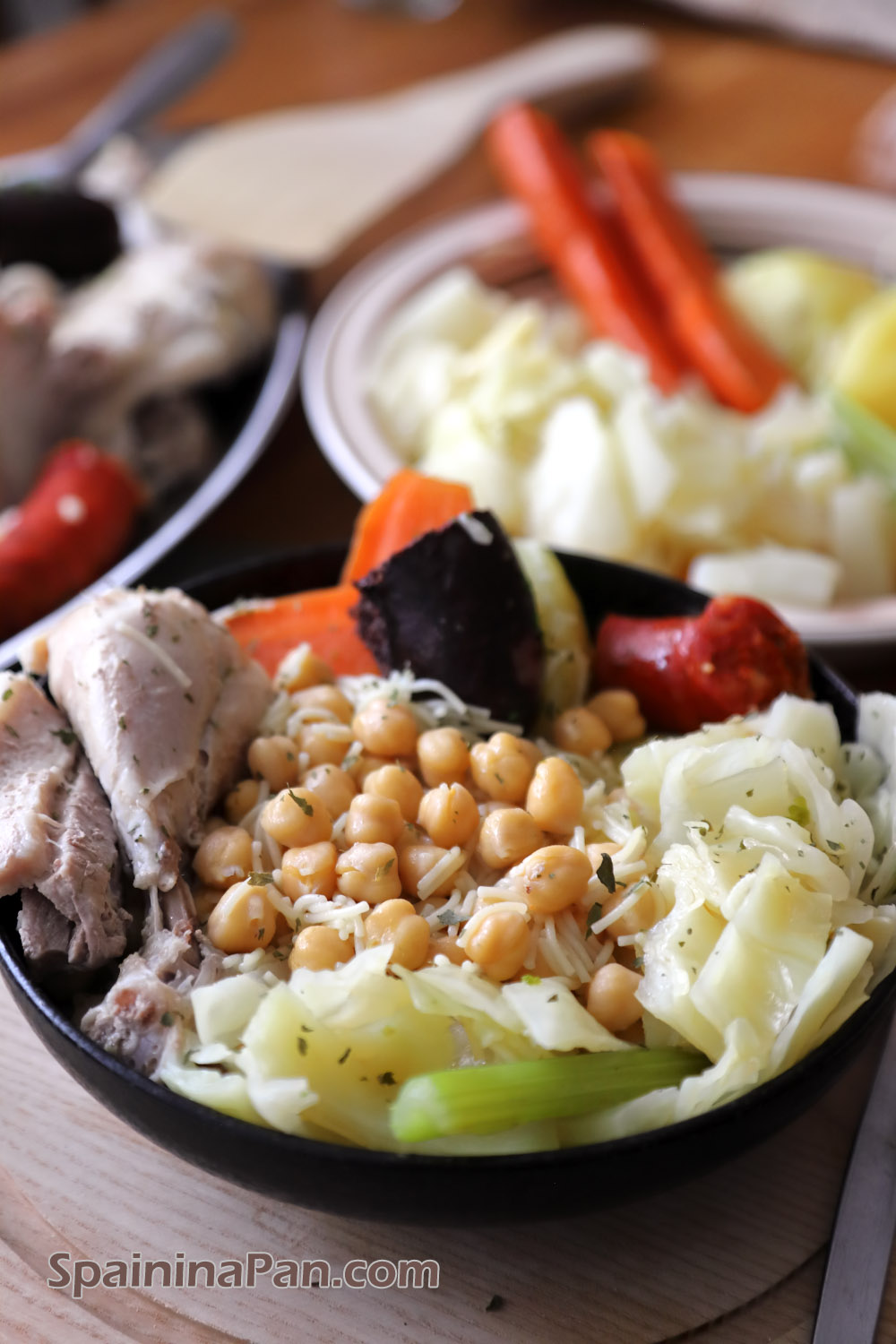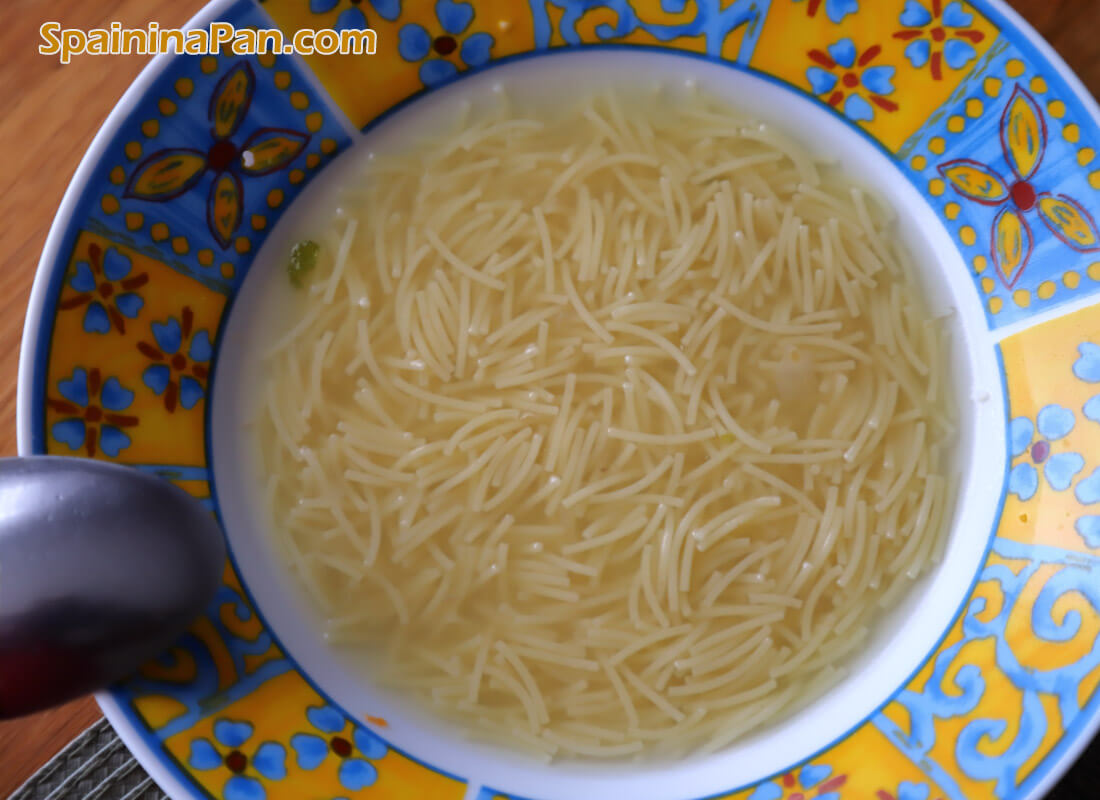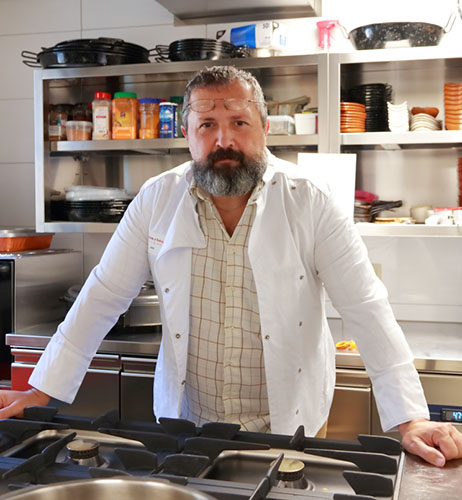- HOME
- Cocido Stews
Authentic Madrilenian Cocido Stew – Traditional Comfort Food
(Cocido Madrileño)
By Edu Valor / Author - Spanish Chef
Cocido was a staple in our family meals. We usually made a simpler version of the Madrilenian cocido stew or sometimes the Andalusian one.
We didn’t use cabbage, but it still had that familiar cocido flavor. I’ve always thought it tastes exceptional with tocino añejo (aged pork fat), even though that’s not a standard ingredient in the Madrid version.
What I love about the stew is how natural and wholesome it feels, and if there's meat and broth left you could make tasty cocido croquettes.
 Rich, delicious, and comforting cocido.
Rich, delicious, and comforting cocido.
It’s one of the most honest, traditional dishes you can find in Spanish cooking. There are countless versions across Spain, and honestly, I haven’t tried them all. I know the Madrilenian and Andalusian cocido stews well—and of course, the versions we made at home.
Two I still want to try are:
- Cocido Maragato
- Cocido Montañés
I’m sure there are plenty more worth exploring, but for now, I stick with the ones I know best. While cocido is considered a classic winter dish, I never hesitated to enjoy it in the middle of summer.
Why would I? It’s rich, hearty, packed with protein and calories—perfect fuel for anyone who lives an active life.
Let's Make a Healthful Madrilenian Cocido Stew!
Ingredients for 4 servings
Preparation: 20-25 minutes
Cooking: Approx. 1 hour for the meat with chickpeas on medium-low fire, 20-25 minutes for vegetables with sausages. 5 minutes for the vermicelli.
*Measurements in metric and USA Imperial system. For British/Canadian measurements please use the metric conversion calculator.
- 300g/10.5 oz garbanzo (chickpeas) soaked overnight (or at least 10 hours)
- 1 chicken leg quarter (remove skin)
- 300g/10.5 oz beef shank (porkcrown or porkchop works too)
- 80g/3 oz jamon or jamon bone (optional)
- 1 blood sausage (with onion or rice are good)
- 200g/7 oz chorizo
- 150g/5.5 oz bacon (preferably in one piece)
- ½ white or green cabbage
- 2 medium carrots
- 2 potatoes
- 1 celery stalk (optional)
- 3 garlic cloves minced
- 1 hand of chopped parsley
- seasalt
Instructions
- Cook the Meats and Bones
Place all the meat and bones in a large stockpot. Add enough water to cover everything completely—about 2 inches (5 cm) above the ingredients. Bring the water to a boil over high heat, then reduce to medium-low. Cover the pot. -
Skim the Broth
After 10–15 minutes, skim off the foam and impurities from the surface using a skimmer or fine-mesh strainer. -
Add Garbanzos (Chickpeas)
Stir in the soaked chickpeas and season with salt to taste. Cover and let the stew simmer on medium-low heat for 50 to 60 minutes. -
Prep the Vegetables
While the stew simmers, remove a few leaves and cut the cabbage into bite-sized pieces. Trim the ends off the carrots and slice them in half lengthwise. Peel the potatoes and cut them in half. -
Start the Vegetable and Sausage Pot
About 20 minutes before the meat and chickpeas are done, ladle enough broth into a separate pot. Add the cabbage, parsley, garlic, chorizo, and blood sausage. Season to taste. Cover and cook over medium heat for 20–25 minutes, or until the cabbage is tender to your liking. - 20 minutes before the end, add the carrot and potato halves to the meat and chickpeas.
- Place the meats on a serving tray with the sausages. Remove the garbanzos with potatoes and carrots too and arrange them on a separate tray with the other vegetables.
- Finish with Vermicelli
In the meat pot, add a generous handful (or 2) of vermicelli noodles to the broth. Cook uncovered for about 5 more minutes, or until they are tender.
TIPS:
- Cut up the done meat and sausages to make 4 servings.
- Mind the broth when bringing the meat pot to a boil. It can boil over.
- The vegetables pot with sausages doesn't need a lot of broth to cook.
- Use jarred or canned garbanzos if needed.
- Rinse the vegetables.
 The traditional first course - vermicelli soup with cocido broth.
The traditional first course - vermicelli soup with cocido broth.
What You Will Need
- Two cooking pots with cover
- Ladle
- Meat knife
- Paring knife
- Cutting board
- Measuring beaker
- Scale
- Colander
How Cocido Madrileño Is Traditionally Served – The Three-Step Ritual
In Spanish cuisine, cocido is traditionally served in what’s called tres vuelcos—literally, “three servings” or “three pours.” Once the stew is ready, it’s separated into three parts:
- The broth – served as the first course, often with vermicelli noodles
- The legumes and vegetables – typically chickpeas, potatoes, and carrots
- The meats – like pork, beef, chorizo, and sometimes morcilla (blood sausage)
Many restaurants serve it in just two courses: first, the broth with noodles; then, the chickpeas, vegetables, and meats together.
At home, we didn’t follow the three-step tradition strictly. We usually served two courses: first, chickpeas with noodles and vegetables; then came the meats.
Sometimes, we just threw everything onto one plate—meat, chorizo, blood sausage, bacon, and all. That’s the version you’ll see in the first photo above.
That was my favorite way to eat it. Why? Because I could make pringá—pulling apart all the meats, mixing them together, and making a satisfying sandwich afterward.
It's so good, some restaurants in Andalusia are selling and serving it in a bread bun.
The second course was always the best part. It’s what made the Madrilenian cocido stew so tasty.
*****




